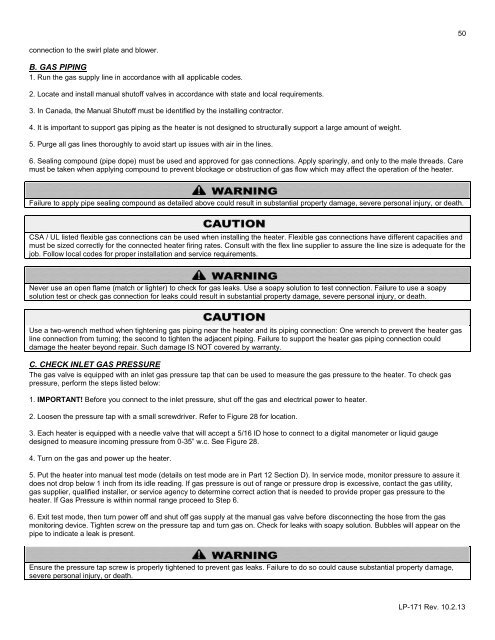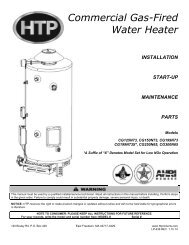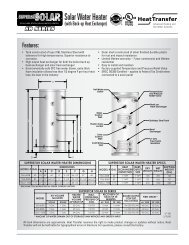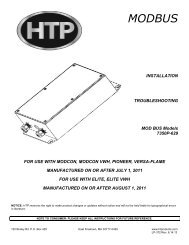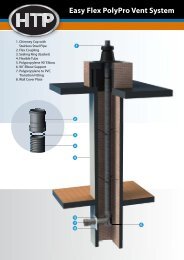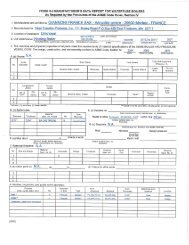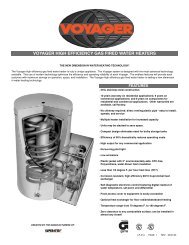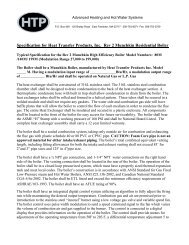MC Series Gas-Fired Circulating Heater - Heat Transfer Products, Inc
MC Series Gas-Fired Circulating Heater - Heat Transfer Products, Inc
MC Series Gas-Fired Circulating Heater - Heat Transfer Products, Inc
You also want an ePaper? Increase the reach of your titles
YUMPU automatically turns print PDFs into web optimized ePapers that Google loves.
50<br />
connection to the swirl plate and blower.<br />
B. GAS PIPING<br />
1. Run the gas supply line in accordance with all applicable codes.<br />
2. Locate and install manual shutoff valves in accordance with state and local requirements.<br />
3. In Canada, the Manual Shutoff must be identified by the installing contractor.<br />
4. It is important to support gas piping as the heater is not designed to structurally support a large amount of weight.<br />
5. Purge all gas lines thoroughly to avoid start up issues with air in the lines.<br />
6. Sealing compound (pipe dope) must be used and approved for gas connections. Apply sparingly, and only to the male threads. Care<br />
must be taken when applying compound to prevent blockage or obstruction of gas flow which may affect the operation of the heater.<br />
Failure to apply pipe sealing compound as detailed above could result in substantial property damage, severe personal injury, or death.<br />
CSA / UL listed flexible gas connections can be used when installing the heater. Flexible gas connections have different capacities and<br />
must be sized correctly for the connected heater firing rates. Consult with the flex line supplier to assure the line size is adequate for the<br />
job. Follow local codes for proper installation and service requirements.<br />
Never use an open flame (match or lighter) to check for gas leaks. Use a soapy solution to test connection. Failure to use a soapy<br />
solution test or check gas connection for leaks could result in substantial property damage, severe personal injury, or death.<br />
Use a two-wrench method when tightening gas piping near the heater and its piping connection: One wrench to prevent the heater gas<br />
line connection from turning; the second to tighten the adjacent piping. Failure to support the heater gas piping connection could<br />
damage the heater beyond repair. Such damage IS NOT covered by warranty.<br />
C. CHECK INLET GAS PRESSURE<br />
The gas valve is equipped with an inlet gas pressure tap that can be used to measure the gas pressure to the heater. To check gas<br />
pressure, perform the steps listed below:<br />
1. IMPORTANT! Before you connect to the inlet pressure, shut off the gas and electrical power to heater.<br />
2. Loosen the pressure tap with a small screwdriver. Refer to Figure 28 for location.<br />
3. Each heater is equipped with a needle valve that will accept a 5/16 ID hose to connect to a digital manometer or liquid gauge<br />
designed to measure incoming pressure from 0-35” w.c. See Figure 28.<br />
4. Turn on the gas and power up the heater.<br />
5. Put the heater into manual test mode (details on test mode are in Part 12 Section D). In service mode, monitor pressure to assure it<br />
does not drop below 1 inch from its idle reading. If gas pressure is out of range or pressure drop is excessive, contact the gas utility,<br />
gas supplier, qualified installer, or service agency to determine correct action that is needed to provide proper gas pressure to the<br />
heater. If <strong>Gas</strong> Pressure is within normal range proceed to Step 6.<br />
6. Exit test mode, then turn power off and shut off gas supply at the manual gas valve before disconnecting the hose from the gas<br />
monitoring device. Tighten screw on the pressure tap and turn gas on. Check for leaks with soapy solution. Bubbles will appear on the<br />
pipe to indicate a leak is present.<br />
Ensure the pressure tap screw is properly tightened to prevent gas leaks. Failure to do so could cause substantial property damage,<br />
severe personal injury, or death.<br />
LP-171 Rev. 10.2.13


